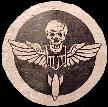After my father finished his training, he was sent overseas to join the 490th Bomber Squadron. The 490th Bomber Squadron was part of the 14th Air Force. At that time, the United States Air Force did not exist as a separate branch of the armed forces. Instead it was a part of the U.S. Army.
The 490th began in India on 15 September 1942, when the 490th Bombardment, Squadron (Medium) was activated. The first combat mission was flown on 18 February 1943 in B-25 Mitchell bombers bearing the now famous "Skull and Wings" insignia, an adaptation of the personal insignia of the commanding officer at that time, Major James A. Philpott.
The squadron bombed bridges, locomotives, railroad yards, and other targets in an effort to harass the movement of supplies to the Japanese troops fighting in northern Burma. In the beginning, many bridge-bombing missions were initially unsuccessful. Despite trying high-level, low-level, dive bombing, and skip-bombing tactics, the U.S. army had many unsuccessful missions against these difficult targets.
The 490th changed all that on New Years Day, 1944, when Major Robert A. Erdin, squadron leader for the day, accidentally discovered a very effective method for destroying bridges. Once perfected, his hop-bombing technique became so successful that the 490th earned the nickname "Burma Bridge Busters" from the commanding general of the Tenth Air Force. In the words of one war correspondent, the 490th became "one of the most specialized bombardment squadrons in the world."
After the war ended, the squadron returned to Camp Kilmer, New Jersey, where it was deactivated on 2 November 1945. During its three years of activities, the fighting 490th destroyed 191 major bridges in Burma, Thailand, and southwest China; received 1280 individual citations; and was awarded two Distinguished Unit Citations. These achievements cost the squadron 185 crew members killed in action.
The 490th began in India on 15 September 1942, when the 490th Bombardment, Squadron (Medium) was activated. The first combat mission was flown on 18 February 1943 in B-25 Mitchell bombers bearing the now famous "Skull and Wings" insignia, an adaptation of the personal insignia of the commanding officer at that time, Major James A. Philpott.
The squadron bombed bridges, locomotives, railroad yards, and other targets in an effort to harass the movement of supplies to the Japanese troops fighting in northern Burma. In the beginning, many bridge-bombing missions were initially unsuccessful. Despite trying high-level, low-level, dive bombing, and skip-bombing tactics, the U.S. army had many unsuccessful missions against these difficult targets.
The 490th changed all that on New Years Day, 1944, when Major Robert A. Erdin, squadron leader for the day, accidentally discovered a very effective method for destroying bridges. Once perfected, his hop-bombing technique became so successful that the 490th earned the nickname "Burma Bridge Busters" from the commanding general of the Tenth Air Force. In the words of one war correspondent, the 490th became "one of the most specialized bombardment squadrons in the world."
After the war ended, the squadron returned to Camp Kilmer, New Jersey, where it was deactivated on 2 November 1945. During its three years of activities, the fighting 490th destroyed 191 major bridges in Burma, Thailand, and southwest China; received 1280 individual citations; and was awarded two Distinguished Unit Citations. These achievements cost the squadron 185 crew members killed in action.

